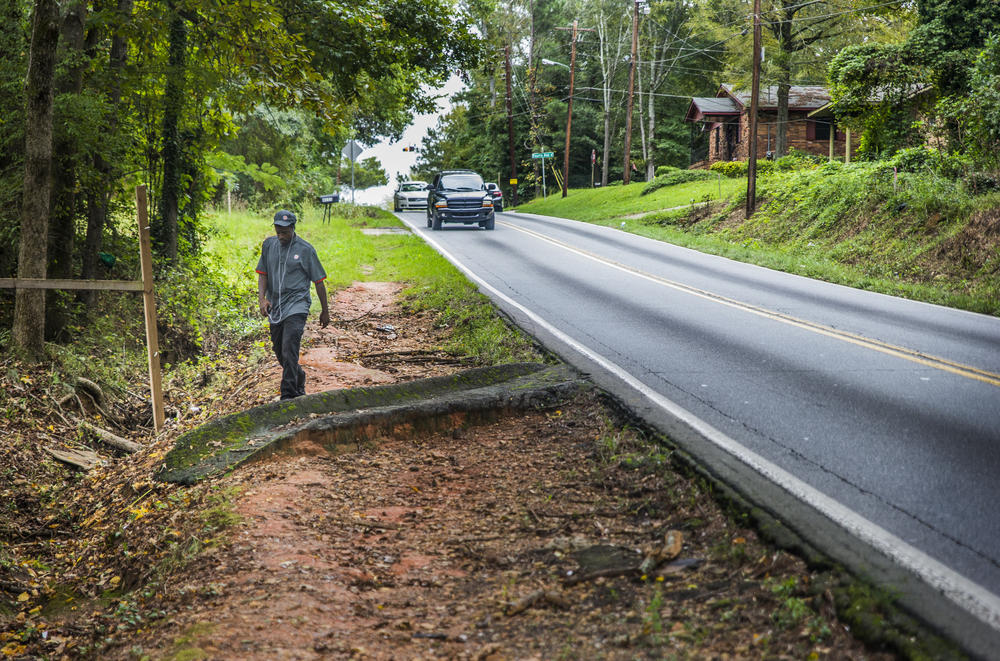
Section Branding
Header Content
A Long Wait For A Short Sidewalk
Primary Content

Andre Wooten makes this walk twice a day, six days a week.
It’s a short walk.
Just off the bus and past the caution light, then down the hill to his apartment on Log Cabin Drive. Along the way he is forced to walk through shin-high grass, then in a red clay ditch, just to avoid being hit by speeding cars on this two lane road. This walk isn’t even as long as a football field.
“That’s as far as I’m going to walk though,” Wooten says. “I would not walk this street.”
Just past the parking lot of his apartment complex is the two lane bridge across Rocky Creek. Get caught there and your options are car or creek. Somehow, no pedestrian accidents have been recorded here in the last fifteen years. Still, standing here it isn’t hard to see why Macon-Bibb County leads Georgia in pedestrian fatalities.
“I would not walk on that bridge. I do not walk that way,” Andre Wooten says.
Up the next hill is a drug store, and a little further a pair of grocery stores and a large shopping center. Wooten isn’t getting to any of that without wheels.
“They do need sidewalks, just to let you know,” he says.
The idea that this almost mile long stretch of road needs sidewalks isn’t new.
At the Bibb County Engineering Office, Bill Causey is leafing through hanging folios of old blueprints looking for just such an old plan. When he finds it, he hoists it to a drafting table with an audible grunt. It lands with a solid thunk.
He reads off the project description, “Northwest Parkway. Project Number 10. From Vineville to Log Cabin. Four lanes divided, curb and gutter sidewalks, storm drainage…”
In the 1990s, Causey was Macon’s City Engineer. The Northwest Parkway project was one of a number of massive Georgia Department of Transportation projects he kept track of.
The Northwest Parkway was meant to speed people from the affluent north end of Bibb County to the county’s southern tip and dump them onto the road to Robins Air Force Base, the region’s major employer. It’s four lanes with a turn lane in the middle would have obliterated an old school now used as a Head Start center as it cut through old neighborhoods. Ironically, much of the opposition to the project came from outside those affected neighborhoods.
Here on Log Cabin Drive, though, people were ready for it.
“I don’t recall any controversy about it,” Bill Causey says. “Everyone that lived on Log Cabin at the time was told you’ll get sidewalks when the Northwest Parkway is built through here.”
While the State of Georgia was promising a $300 million project with sidewalks on Log Cabin Drive, Causey was pushing a smaller, locally funded plan for sidewalks for nearby Tucker Road. He was not met with open arms. There, amid subdivisions and the Idle Hour Country Club, he met resistance. Causey says residents were afraid sidewalk would just encourage outsiders to case the neighborhood. Break in and steal stuff.
Even given the push back, the Tucker Road project had one feature working in its favor that the Log Cabin Project didn’t.
“Some projects didn’t have GDOT funding so we had a little more flexibility,” Causey says.
With the flexibility to deviate from the Georgia DOT massive multi-lane template and just get by with what they had, locals got the Tucker Road project done. That’s even in the face of vocal local opposition. Today the Tucker Road path is popular with joggers and walkers.
Meanwhile, the political momentum for huge road projects like the Northwest Parkway stopped cold. Once Georgia took back its millions, the Log Cabin piece of the project bounced from office to office in what would be a long, slow death. That left the sidewalks on Log Cabin Drive about a mile short and about a thousand feet from the caution light where Andre Wooten starts his daily walk. So why didn’t the local government swing in and at least finish sidewalks a la Tucker Road?
“I can’t answer that,” Bill Causey says. “It just wasn’t on anybody’s radar.”
Bibb County Commission Member Al Tillman doesn’t degrudge the people on Tucker Road their sidewalks.
“Not at all. I think sidewalks are needed,” Tillman says. You know people get hit on bicycles and so forth. And so you can’t just have people walking in the middle of the street.”
Log Cabin Drive is in Tillman’s Commission District. He’s only been an elected official since 2014. During a drive up and down drive Log Cabin Drive he talks about the project.
“Believe it or not, in May of 2016 we will be running again for office,” he says.
Tillman says people in this neighborhood are justifiably anxious to finally see something get done here after 20 some odd years of waiting. He has good news.
“Believe it or not, we are closer than we have ever been to completing this project. Or starting this project,” Tillman says.
Plans for what is now a retrofit of sidewalks and a pedestrian bridge around the narrow two lane road are almost finalized. Tillman points to $1.5 million in special local option sales tax, or SPLOST, money that is dedicated to it. Though the plans are new, the money isn’t. It was set aside back in 2011. Turns out this version of the Log Cabin project could have started four years ago. Why the delay?
“I think it’s leadership. You have to be honest, it’s leadership,” Tillman says. “What happens is the money that becomes available through SPLOST projects, you’ve got to have the administration and a city council and commissioners that’s willing to make sure these projects go through. And that’s not been happening.”
Tillman points to the obvious progress on the renovation of Second Street in Macon’s still recovering downtown as a SPLOST project that took political precedence.
“We get sidetracked. Or they’ve gotten sidetracked,” he says.
Tillman stops to look at a house slated for demolition for the project. A little over $250,000 of the $1.5 million is set aside for property acquisition that hasn’t happened yet. Then he swings by Jessie Green’s house. He went to high school with her son Bernard.
“Ms. Green in the house?” he shouts.
The men working in the car detailing business in the backyard don’t hear him. He shouts again.
“Ms. Green in the house? Just tell her we’re closer than ever.” he says before stopping his truck to catch up with Bernard.
“Look at my man there. What’s up my man?”
Jessie Green has lived here for something like 40 years.
When she came here, Fourth Avenue, the street that along with Log Cabin Drive makes the corner where home sits, was dirt. Bernard, Al Tillman’s high school friend, was a babe in her arms.
“Bernard? You’re 47? 48?” she asks by way of counting up the years.
A few days before Al Tillman swings by, she is in her living room. The TV is on. The caution light where Andrew Wooten starts his walk home is just outside her front door.
“In fact that caution light was not here when I moved here,” she says. “And I talked with someone about that. And they soon put up the caution light.”
She worries about the speed on the road outside as well as about the walkers. She says over the years she has talked with politicians about making things safe.
“But I haven’t been able to get hold of Mr. Tillman,” she says. “ I would love to talk with him about it.”
She says she knows about the house diagonally from her, the one Al TIlman will point out a few days later, that it will be demolished. She would love to know what the project might mean for her.
“I don’t really have a fear of losing the house,” she says. “But I don’t really want to walk out my front door and into the road either.”
At this point though, she says she just wants to see some progress. By now she has her doubts.
“I feel like at the rate it’s been going, I might not even be alive when this is done,” she says.
The Log Cabin Drive project is expected to go out for bid by the end of 2015.
(This story also appears on Medium).
Tags: Grant Blankenship, Macon, Georgia, transportation, walking, cities, urban, government, pedestrian, safety
Bottom Content

